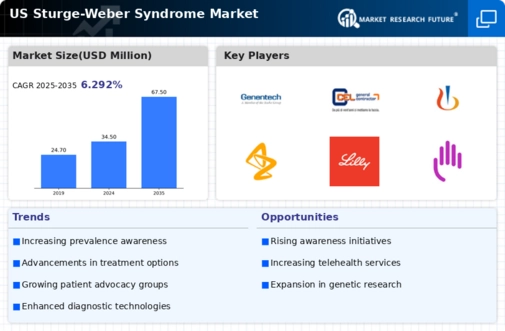Support from Patient Advocacy Groups
Support from patient advocacy groups plays a vital role in shaping the sturge weber-syndrome market. These organizations provide resources, education, and support for individuals affected by SWS, fostering a sense of community and empowerment. Their efforts in lobbying for research funding and raising awareness can lead to increased visibility of the syndrome. As advocacy groups continue to push for better treatment options and healthcare policies, the market may see a rise in funding and resources allocated to SWS research. This support is likely to enhance the overall landscape of care for patients, potentially driving growth in the market.
Advancements in Diagnostic Technologies
Technological advancements in diagnostic tools are significantly impacting the sturge weber-syndrome market. Innovations such as advanced imaging techniques, including MRI and CT scans, have improved the accuracy of SWS diagnoses. These technologies enable earlier detection and intervention, which is crucial for managing the condition effectively. The market is likely to benefit from the integration of artificial intelligence and machine learning in diagnostic processes, enhancing the precision of identifying SWS. As diagnostic capabilities improve, healthcare providers can offer more tailored treatment plans, which may lead to better patient outcomes. This trend suggests a potential increase in the market size as more patients receive timely and accurate diagnoses.
Rising Incidence of Sturge Weber Syndrome
The increasing incidence of Sturge Weber Syndrome (SWS) in the United States is a notable driver for the sturge weber-syndrome market. Recent estimates suggest that SWS affects approximately 1 in 20,000 live births, leading to a growing patient population requiring specialized care. This rise in cases necessitates enhanced diagnostic and therapeutic options, thereby stimulating market growth. As awareness of the syndrome increases among healthcare professionals and the general public, more patients are likely to seek medical attention, further driving demand for treatments. The sturge weber-syndrome market is thus positioned to expand as healthcare providers adapt to the needs of this growing demographic, potentially leading to increased investments in research and development of effective therapies.
Development of Novel Therapeutic Approaches
The development of novel therapeutic approaches is a significant driver for the sturge weber-syndrome market. Recent research has focused on targeted therapies and personalized medicine, which may offer more effective treatment options for patients with SWS. These advancements could lead to improved management of symptoms and overall quality of life. The market is likely to experience growth as pharmaceutical companies invest in research and development of innovative treatments. Additionally, collaborations between academic institutions and biotech firms may accelerate the discovery of new therapies. This trend suggests a promising future for the market as new treatment modalities become available.
Increased Awareness and Education Initiatives
Awareness and education initiatives surrounding Sturge Weber Syndrome are crucial drivers for the sturge weber-syndrome market. Organizations dedicated to SWS are actively working to educate both healthcare professionals and the public about the syndrome. This increased awareness is likely to lead to earlier diagnoses and more patients seeking treatment. Furthermore, educational campaigns can help reduce stigma and improve the quality of life for those affected. The market may see a rise in demand for therapies and support services as more individuals become informed about their condition. This trend indicates a potential for growth in the market as awareness translates into increased healthcare utilization.

















Leave a Comment